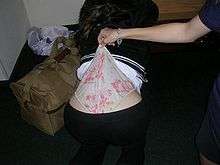Wedgie
A wedgie is the act of forcibly pulling a person's underpants upwards from the back. The act is often performed as a school prank or a form of bullying.
| Look up wedgie, atomic wedgie, or melvin in Wiktionary, the free dictionary. |

Wedgies are commonly featured in popular works, either as a form of low comedy or as a behaviour representative of bullying. In such works, briefs are usually the type of underpants that are worn by the victim.[1][2]
Dangers
Wedgies, especially when performed on males, can be dangerous, potentially causing testicular or scrotal damage. An incident in 2004 involving a ten-year-old boy required reattachment of a testicle to the scrotum.[3]
Variations

As a prank or form of bullying, there are a number of variants to the normal, or traditional wedgie. It is impractical to list every variant, as the names and processes can be rather subjective; however, there are a few better-known variants of the wedgie.
- The melvin is a variant where the victim's underwear is pulled up from the front, to cause injury, or, at least, severe pain to the victim's genitals.[4] The female variant is sometimes called a minerva.
- The atomic wedgie entails hoisting the waistband of the receiver's underwear up and over their heads.[4] This form is the title character's signature prank from The Mask: The Animated Series.
- The hanging wedgie is a variant in which the victim is hung from his or her underwear, elevated above the ground.[5]
References
- Wedgie. The American Heritage Dictionary of the English Language, Fourth Edition. Houghton Mifflin Company, 2004. Retrieved 30 November 2007 via Dictionary.com.
- No More Bullies, School Counselor Resources.
- "Emergency operation after school prank - Local stories". Yorkshire Post. 2 December 2004. Retrieved 1 August 2012.
- Curran, David (4 January 2007). "Gwyneth And 'The Atomic Wedgie'". San Francisco Chronicle. Retrieved 7 July 2009.
- Stuever, Hank (2 September 2002). "At School, a Most Uncomfortable Subject". The Washington Post. Retrieved 7 July 2009.